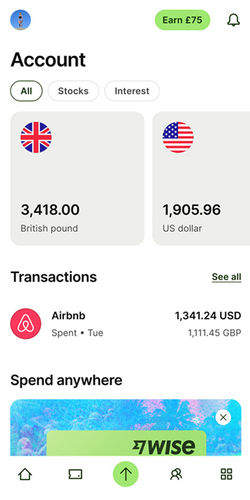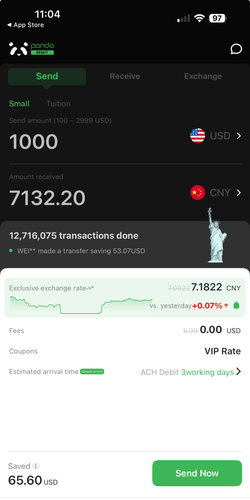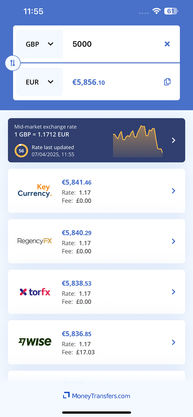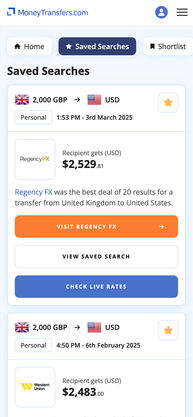Compare the best ways to send money to Sri Lanka
Get the best deals when you transfer money to Sri Lanka. Find the cheapest, fastest, and most reliable providers with the best LKR exchange rates.
Read on for the best LKR deals, expert information, and all you need to transfer money to Sri Lanka.
Send money to Sri Lanka
"Over 16 million customers use Wise, mostly for their excellent mobile app, transparent fee structure & use of mid-market rates. Now increasingly used for larger transfers."
"Over 16 million customers use Wise, mostly for their excellent mobile app, transparent fee structure & use of mid-market rates. Now increasingly used for larger transfers."
"Over 16 million customers use Wise, mostly for their excellent mobile app, transparent fee structure & use of mid-market rates. Now increasingly used for larger transfers."
"Xe has over 30 years of currency exchange experience, and is one of the most reputable names on the market. 200 countries, 100 currencies, & funds often received in seconds."
"Xe has over 30 years of currency exchange experience, and is one of the most reputable names on the market. 200 countries, 100 currencies, & funds often received in seconds."
"Xe has over 30 years of currency exchange experience, and is one of the most reputable names on the market. 200 countries, 100 currencies, & funds often received in seconds."
"Over 16 million customers use Wise, mostly for their excellent mobile app, transparent fee structure & use of mid-market rates. Now increasingly used for larger transfers."
"Over 16 million customers use Wise, mostly for their excellent mobile app, transparent fee structure & use of mid-market rates. Now increasingly used for larger transfers."
"Over 16 million customers use Wise, mostly for their excellent mobile app, transparent fee structure & use of mid-market rates. Now increasingly used for larger transfers."
"Revolut has 50+ million customers globally. You can hold up to 36 currencies in the app and send money quickly in 70+ currencies to 160+ countries."
"Revolut has 50+ million customers globally. You can hold up to 36 currencies in the app and send money quickly in 70+ currencies to 160+ countries."
"Revolut has 50+ million customers globally. You can hold up to 36 currencies in the app and send money quickly in 70+ currencies to 160+ countries."
"Xe has over 30 years of currency exchange experience, and is one of the most reputable names on the market. 200 countries, 100 currencies, & funds often received in seconds."
"Xe has over 30 years of currency exchange experience, and is one of the most reputable names on the market. 200 countries, 100 currencies, & funds often received in seconds."
"Xe has over 30 years of currency exchange experience, and is one of the most reputable names on the market. 200 countries, 100 currencies, & funds often received in seconds."
"OFX have been helping individuals and businesses send money for over 25 years. Transfer in 50+ currencies to 170+ countries, with 24/7 phone access to currency experts."
"OFX have been helping individuals and businesses send money for over 25 years. Transfer in 50+ currencies to 170+ countries, with 24/7 phone access to currency experts."
"OFX have been helping individuals and businesses send money for over 25 years. Transfer in 50+ currencies to 170+ countries, with 24/7 phone access to currency experts."
"Remitly focuses on sending money to friends and family in Asia, Africa and South America. Wide coverage and well-suited to regular transfers home."
"Remitly focuses on sending money to friends and family in Asia, Africa and South America. Wide coverage and well-suited to regular transfers home."
"Remitly focuses on sending money to friends and family in Asia, Africa and South America. Wide coverage and well-suited to regular transfers home."
"Xoom, a PayPal service, allows you to send money in more than 160 countries. You can send cash for over-the-counter pickup or home delivery, as well as send by bank transfer or debit card."
"Xoom, a PayPal service, allows you to send money in more than 160 countries. You can send cash for over-the-counter pickup or home delivery, as well as send by bank transfer or debit card."
"Xoom, a PayPal service, allows you to send money in more than 160 countries. You can send cash for over-the-counter pickup or home delivery, as well as send by bank transfer or debit card."
"Sendwave is trusted by over 1 million users across the US, UK, Canada and EU. 24/7 support is available online and via the app."
"Sendwave is trusted by over 1 million users across the US, UK, Canada and EU. 24/7 support is available online and via the app."
"Sendwave is trusted by over 1 million users across the US, UK, Canada and EU. 24/7 support is available online and via the app."
"Ria Money Transfer has over 35 yeas of trusted experience. Send money online to over 190 countries, and to over 500,000 pickup locations."
"Ria Money Transfer has over 35 yeas of trusted experience. Send money online to over 190 countries, and to over 500,000 pickup locations."
"Ria Money Transfer has over 35 yeas of trusted experience. Send money online to over 190 countries, and to over 500,000 pickup locations."
"Send money to over 40 destinations online and in the mobile app."
"Send money to over 40 destinations online and in the mobile app."
"Send money to over 40 destinations online and in the mobile app."
"Paysend has transparent fees and rates, with transfer sent within seconds to your recipient's bank. They also have global 24/7 support for any enquiries, and bank-level security."
"Paysend has transparent fees and rates, with transfer sent within seconds to your recipient's bank. They also have global 24/7 support for any enquiries, and bank-level security."
"Paysend has transparent fees and rates, with transfer sent within seconds to your recipient's bank. They also have global 24/7 support for any enquiries, and bank-level security."
"Moneygram is a well established service with over 80 years in the sector. They support over 200 countries worldwide and have over 440,000 retail locations."
"Moneygram is a well established service with over 80 years in the sector. They support over 200 countries worldwide and have over 440,000 retail locations."
"Moneygram is a well established service with over 80 years in the sector. They support over 200 countries worldwide and have over 440,000 retail locations."
How to send money to Sri Lanka with the best rate
Always compare rates
Don't pay more than you have to. Use our live comparison tool to make sure you aren't missing the best rates when sending money to Sri Lanka.
Choose a provider
Select the provider that offers you the most LKR and fits your needs.
Click, sign up & send
Follow the steps & make your transfer. Your funds will soon be on their way to your chosen country & currency.
The best way to send money to Sri Lanka: Wise
After reviewing and testing 11 money transfer providers supporting LKR transfers, we found Wise to be the top choice for money transfers to Sri Lanka as of January 2026.
With quick transfers, a low markup of 0.11% on LKR exchange rates, and a low fee of $21.51, Wise offers the ideal balance of cost, speed, and features for LKR transfers.

Remitly is the cheapest way to send money to Sri Lanka
Remitly charges $0 per transfer and adds a 0.41% markup on top of the Sri Lank Rupee exchange rate.
bank transfer is the cheapest funding option when sending money to Sri Lanka. Pair it together with Remitly, to get the most out of your LKR transfer.

Panda Remit: The fastest way to send money to Sri Lanka
With Panda Remit, the transfer time to Sri Lanka is minutes - 24 hours.
They charge $4 in fees and apply a 0.3% markup on the LKR exchange rate, which is 0% better than the second-best option.
For the best combination of cost and speed, we suggest using bank transfer to fund your LKR transfer.

Easiest way to send money to Sri Lanka: Wise
We recommend Wise if you are after convenience. Their app is made for LKR transfers on the go, their fees are low, and transfer times are fast.
They may not always be the cheapest or the fastest for transfers to Sri Lanka, but the difference would be minimal, especially on smaller LKR transfers.
By “easiest”, we mean the service that is easy to get started with, is fully transparent, and offers a good balance of cheap and fast transfers.

Understanding money transfers to Sri Lanka
Always compare your transfer options to Sri Lanka, don't settle for the most popular choice.
Almost all services supporting LK will include the fees and the markup on the ‘real’ LKR rate.
It will heavily depend on your deposit method, delivery options, the amount of LKR you send, and your location.
Our comparison includes 11 providers offering money transfer services to Sri Lanka.
Sending large amounts of LKR to Sri Lanka
Wise consistently ranked as the top choice for large LKR transfers. They charge $21.51 per transfer to Sri Lanka and apply only a 0.11% markup on the LKR exchange rate.
Whether you’re purchasing property, paying tuition fees in LKR, planning a wedding in Sri Lanka, or making business payments, Wise ensures a smooth and secure process.
When sending large amounts of Sri Lank Rupee to Sri Lanka, consider factors like transfer limits, markup on the LKR rate, customer service, and any legal, tax, or government-imposed restrictions in Sri Lanka.

Understanding the costs involved when moving money to Sri Lanka
When calculating the cost of money transfers to Sri Lanka, here's what really matters: the country of origin, amount, payment method, fees, and the markup on the LKR exchange rate.
Exchange rate markup
This is a percentage added on top of the "real" LKR rate (known as the mid-market rate).
Wise, for example, offers the best exchange rate. It adds 0.11% markup to the USD-LKR exchange rate (309.881 LKR - 0.11% per US Dollar).
Transfer fees
These are fixed and/or percentage fees added for the service when sending money to Sri Lanka.
Let's imagine you want to send $3,000 from the US to Sri Lanka.
After analyzing 11 companies supporting Sri Lank Rupee, we found Remitly to offer the lowest fees ( $0 in fees and 0.41% markup).
However, exact fees vary by deposit method and the service, for example:
Bank transfers vary from $0 to $210.00000000000003
Debit cards range from $0 to $0
Credit card fees vary a lot, mainly due to cash advance fees and/or additional fees from your credit card provider.

Get the best LKR exchange rate
The exchange rate is the value of the LKR (Sri Lank Rupee) against other currencies, and since it fluctuates, it will affect how much LKR the recipient will get. Sending money when LKR reaches the highest value will result in more LKR for your recipient.
Over the past 7 days, the LKR exchange rate has:
Averaged at 309.8247 Sri Lank Rupee per USD
Reached a high of 310.6932 LKR/USD
Dropped to a low of 309.5998 LKR per US Dollar
You should aim to make a transfer when the rate is closer to 310.6932 LKR/USD . This will give your recipient in Sri Lanka more Sri Lank Rupee.
Pair your transfer with Wise (who offers the best exchange rate), and you will maximize the amount of LKR received.
Get notified when it’s the best time to send LKR
Sign up for our rate alerts, and we’ll notify you when it’s the best time to send LKR!
Payment methods available to fund your transfer to Sri Lanka
Bank transfers
Bank transfers are often the default option for sending money to Sri Lanka.
By using a money transfer company available in Sri Lanka such as Remitly, you can send money via a bank transfer (or ACH) while benefiting from lower fees and more favorable exchange rates.
Remitly is the cheapest provider for bank transfers from the 11 we tested when sending money to Sri Lanka.
They charge 0LKR for sending money to Sri Lanka with a bank transfer, resulting in 925,860 for your recipient.

Debit and prepaid cards
Sending money to Sri Lanka with a debit or a prepaid card is very simple with Xe.
Xe is a leader in debit card payments to Sri Lanka, competing among a total of 11 active money transfer companies.

Credit cards
When it comes to sending LKR via credit card, we to get the best deal today.
Fee alert: using a credit card to transfer money often results in a cash advance fee being charged by your card issuer. That's why we recommend a bank transfer or debit card instead.

How we analyze the market
We track the cost, speed, and product offerings of the leading money transfer services available in Sri Lanka.
Our comparison engine and algorithms evaluate providers based on over 25 factors, including transfer fees, ease of use, exchange rates, mobile apps, transfer times & customer support.
We also consider how these services are rated on platforms like TrustPilot, AppStore, and Google Play, giving you a comprehensive view of what to expect.
This thorough analysis helps you get the best available deal - every time you want to move money to Sri Lanka.
We also provide unbiased and detailed reviews of all the top money transfer companies. You can use these reviews to find the best service for your needs when sending money to Sri Lanka
For a deeper understanding of our commitment to integrity and transparency, we invite you to read our editorial policy and review methodology.

Related transfer routes
Send money from Sri Lanka
Send money to Sri Lanka
FAQs
Find answers to the most common questions on our dedicated FAQ page.
How much money can be transferred to Sri Lanka?
Are there any tax implications to sending money to Sri Lanka?
What are the typical transfer fees for sending money to Sri Lanka?
How long does it take for LKR to reach Sri Lanka?
Are there any min/max limits on LKR transfers?
Can I schedule regular payments to Sri Lanka?
What currency is used in Sri Lanka?
Can I send LKR from any country?
How can I track my money transfer to Sri Lanka?
What should I do if my money transfer to Sri Lanka goes wrong?
Can’t I use my bank to transfer money to Sri Lanka?
Can I send LKR with MoneyTransfers.com?
Tools & resources
Contributors




















